Built in 1904-1908 by the Eighth Bogd Khaan Jebzundamba (the theocratic ruler of Mongolia) and dedicated to his brother the Choijin Lama Luvsanhaidav, the temple complex is now a museum preserving the elaborately decorated interiors and containing a rich collection of other Mongolian Buddhist sculpture and painting. It has several gilded bronze statues (at least one attributed to Zanabazar, the first Bogd Jebzundamba), impressive sculptures of the major Mongolian/Tibetan incarnations of the Buddhist deities, and a striking array of papier-mache masks used for the Tsam dance ceremonies. The photographs here were taken mainly in 2005, with a few from 1979 and 2004, all of them by Daniel Waugh. Reflections of interior lighting on glass cases in some cases were impossible to avoid; so the quality often is not ideal. The captioning is based on cryptic notes and a limited amount of checking in books and on the Internet, but needs further elaboration and correction.

|
View of Urga (now Ulaanbaatar), early 20th century. Copy.
|

|
Diagram of the Choijin Lama building complex.
|




|
Exterior views of complex, including inner side of wall with sculpted relief facing the entrance gate.
|



|
Outer entrance gate (Temple of the Four Maharajas) and detail of one of the statues within (Virupaksa, Guardian King of the West).
|


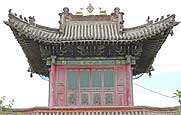

|
Main temple complex, inner entrance gate in foreground; details of entrance gate; view in inner courtyard.
|





|
Main temple (left) and Temple of Amgalan (right), dedicated to the first Bogd Jebzundamba, Undur Gegen Zanabazar; details of sculptures on porch of main temple.
|


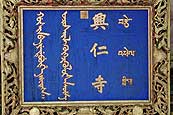

|
Doors of main temple, inscriptions over outer porch and above doors, painting on ceiling to right of latter inscription.
|
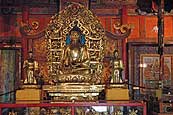
|
Main altar of main temple, with image of Buddha Sakyamuni (18th c.).
|

|
Statue of Choijin Lama, main temple, to right of main altar.
|


|
Decoration along eaves of main (?) temple.
|

|
Ceremonial hat.
|




|
Complete costumes for Tsam Dance, with details of respective masks, the red one (Jamsran) encrusted with coral. The black masked figure may be Lkham (Kali). 19th century.
|



|
Statue of Undur Gegen Zanabazar, the first Bogd Jebzundamba (1635-1724). Gilt bronze.
|




|
Aksobhya (Mintugva).
18th c. Gilt bronze.
School of Zanabazar.
|




|
Maitreya.
Gilt bronze.
Cf. Rhie and Thurman, Wisdom and Compassion (New York, 1996), exp. ed., no. 32.
|




|
Maitreya (?)
|




|
Sitasamvara and consort.
Sculpture by Zanabazar, late 17th c.
Gilt, bronze. H. 54.5 cm.
|
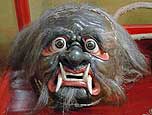
|
Tsam mask.
Spirit of Songgina. Da Khuree style.
19th c. Papier-mache, polychrome, horsehair.
H. 31 cm., W. 33 cm.
|

|
Tsam mask.
Khangard (Garuda).
Spirit of Bogdo Ula. Da Khuree style. 19th c. Papier-mache, polychrome, gilt, silk and cotton.
|
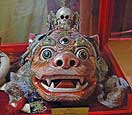
|
Tsam mask.
Dagdam (Bar, tiger).
19th c., papier-mache, polychrome.
|

|
Tsam mask.
Tshoijoo (Yama).
|

|
Tsam mask.
Gongor (Sita Mahakala).
|

|
Tsam mask.
Begze(?).
|

|
Tsam mask.
Shiva (deer).
|

|
|

|
Ditapastra.
Copper alloy.
|

|
Virupaksa.
|

|
|

|
Eleven-headed Avalokitesvara.
|

|
Ushnishavijaya.
|

|
Norbudema-med.
156 x 116.
Publ.: Tsultem, Development of the Mongolian National Style Painting (Ulaanbaatar, 1986), no. 65.
|

|
Vajradhara.
|




|
Cosmic sphere of Amitabha’s abode. 19th c.
|

|
Ushnishavijaya (an emanation of Variochana Buddha).
|

|
Six-armed Mahakala.
|

|
Dorjshugden (Bazarbik?).
|

|
Zencora (? Zunger) on horse. 19th c.
In front, Manjusri on lion (?).
|


|
Regdendagva.
|

|
Peremleijalba (?).
|


|
Haryagriva (?).
|



|
Jamsran.
|
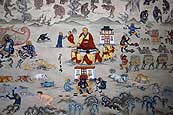
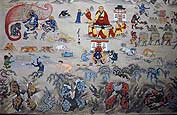
|
|


|
Tsongkhapa (central figure of three). Late 18th c.
|


|
Altar in annex to Main Temple (?).
|

|
Yamantaka with consort.
|

|
|


|
|


























































































